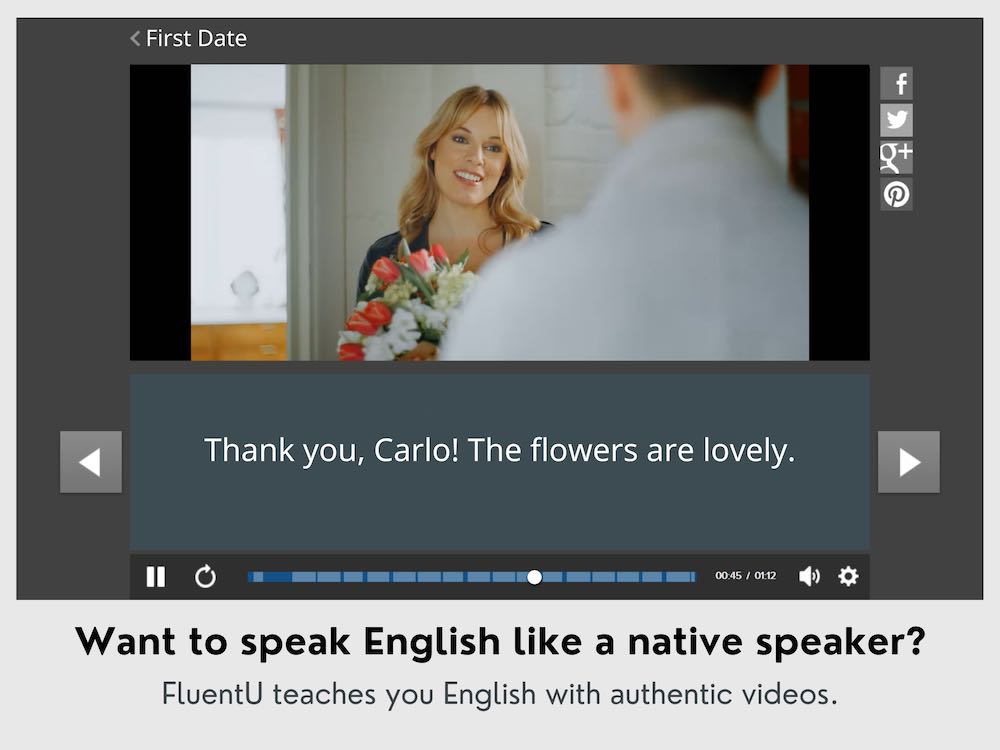
How to Speak English Without an Accent
There’s nothing more frustrating than not being understood.
Even if your pronunciation is almost perfect, many people might have a problem understanding you because of your accent.
For this reason, many English language learners try to lose their foreign accent and talk like first-language English speakers.
Continue reading to learn what resources you can use to accomplish your accent goals.
Contents
- What Is an Accent?
- How to Improve Your English Pronunciation and Lose Your Foreign Accent
- Which Accent Do You Want?
- And One More Thing...
Download: This blog post is available as a convenient and portable PDF that you can take anywhere. Click here to get a copy. (Download)
What Is an Accent?
Accents are distinctive variations in pronunciation and intonation that result from regional, cultural or linguistic differences among speakers of a language. In other words, an accent is the unique way a person speaks their language.
The second thing you need to keep in mind is that everyone has an accent, including all native English speakers.
Accents are great. They add personality to English, and without them, conversations would be boring.
However, not all accents are easy for the average English speaker to understand, which is why it’s a good idea to learn how to speak like a native English speaker.
Mastering English pronunciation and intonation is the first step towards speaking English without a foreign accent.
Just remember that speaking like a native isn’t something that happens overnight. It’s going to take a lot of time and practice. But if you work hard and continue to improve your speaking, you’ll begin to notice that people have an easier time understanding your English in conversations!
How to Improve Your English Pronunciation and Lose Your Foreign Accent
While not impossible, learning how to speak English like a native will take a lot of time and practice—especially for adults. For whatever reason, studies show that children master pronunciation and learn second languages easier than adults. So, if your goal is to teach your child how to speak English without an accent, you should get them practicing as early as possible.
Also, keep in mind that there are three main accents in English: United States (AmE), British (UK) and Australian (AUS), so you’ll probably choose the accent for the place you live or want to live.
If you want to learn how to speak English without an accent, here are some resources to help you get started.
1. Listen to Your Target Accent A Lot
Mastering a native English accent requires you to listen to native speakers and practice speaking with their intonation and pronunciation.
For best results, make sure to actually practice using the accent while listening to podcasts and watching television shows. The best way to do this is to pause and repeat what speakers are saying over and over again. You can also record yourself and listen to how you speak, then compare it to the accents you’re listening to.
Podcasts
If you don’t have any English speakers you can speak with, try listening to podcasts for practice.
- Podcasts for English Language Learners (AmE and UK): In this post, we list some of our favorite British and American English podcasts.
- OzPodcasts (AUS): This directory of Australian podcasts covers a wide range of topics led by authentic Australian English speakers.
TV Shows
Another great way to improve your accent is by watching television shows.
- British and American TV Shows for Learning English (AmE and UK): Both American and British TV is popular worldwide, so you won’t have any problems finding television shows from these two countries. In this post, you can find some of the best shows to learn English, as well as places to watch them online.
- “The Katering Show” (AUS): For a good Australian TV show, take a look at this one. It’s a comedy about two food lovers with very different personalities who find themselves in a number of unusual situations.
Here’s a sample episode:
Authentic clips
You can watch short authentic English video clips on a program like FluentU to become familiar with different your chosen accent. The benefit of using short clips is that you can include them in any schedule, and you can get a lot done in a pretty short time.
FluentU takes authentic videos—like music videos, movie trailers, news and inspiring talks—and turns them into personalized language learning lessons.
You can try FluentU for free for 2 weeks. Check out the website or download the iOS app or Android app.
P.S. Click here to take advantage of our current sale! (Expires at the end of this month.)

2. Practice Pronunciation with YouTube Videos
Good pronunciation is important for talking like a native speaker. Unfortunately, many students skip past textbook pronunciation exercises for other activities, like grammar and vocabulary.
The good news is that practicing pronunciation doesn’t have to be as boring as listen-and-repeat exercises found in textbooks. Here are four YouTube channels that make English pronunciation fun and engaging:
- FluentU English: With real-life examples taken from Hollywood hits, British TV series and many other authentic sources, you can practice your chosen English accent in an entertaining way.
- Speak English with Vanessa (AmE): A great channel with pronunciation lessons on how to speak like an American.
- BBC Learning English’s (UK): More than 100 videos dedicated to pronunciation and how to speak in a standard British accent.
- Aussie English (AUS): Learn a little about Australia and Australian culture while watching more than 40 videos teaching you how to talk like an Australian.
3. Become Aware of Intonation
Everyone knows that good pronunciation is important for learning how to speak English like a native, but many students make the mistake of focusing only on their pronunciation and ignoring intonation completely.
Intonation is the tone you speak in and the stress you put on different parts of a word. English speakers have different intonations depending on where they’re from. For example, when saying “garage,” an American English speaker will say “ga-RAGE,” whereas a British English speaker says “GAR-age.”
Using the wrong intonation doesn’t only confuse native English speakers, it can also change the meaning of your sentence completely. Also, people will know you’re not a first-language English speaker from incorrect intonation much easier than they will if you mispronounce a word or two.
Take a look at this video to see an example of what it sounds like to have good pronunciation and incorrect intonation. While the gentleman in the video clip thinks he doesn’t have an accent, his intonation immediately gives him away as an English language learner. Granted, he speaks just fine and is understood just as easily as a native speaker, but he does have an accent.
4. Practice to Improve Intonation
You can practice your intonation in the same way you improve your pronunciation: by listening to native speakers and repeating what they say while trying to sound like them.
Except with intonation, you’re not focusing on how they’re saying vowels and consonants, but rather how they’re saying entire words—whether they’re being louder at the beginning or the end of the word or if their voice sounds higher or lower at the end of a sentence.
Some good YouTube channels to help you practice your intonation include:
- Jill Diamond (AmE): When it comes to mastering spoken English, Jill Diamond’s videos can have anyone talking like an American. Along with pronunciation tips and talking about different accents, Jill also covers intonation in videos like “Intonation Patterns of American English” and this video:
- English Pronunciation Roadmap (UK): The English Pronunciation Roadmap is filled with helpful videos for English language learners trying to speak British English. Two of their most helpful intonation videos are “Rising and Falling Intonation” and this video:
- ABC Education’s Study English Series (AUS): ABC Education is loaded with resources to help English language learners discover more about English, Australian English and life in Australia. This playlist is especially helpful for learning how to understand Australian accents and speak like an Australian, including this 10-minute episode focusing on Australian intonation:
5. Focus on Phonemes
Phonemes are sounds that make up a language. English has 44 phonemes, which isn’t that many if you think about it.
These are the smallest units of sound in the language.
For example, the word “dog” has three phonemes: /d/, /o/ and /g/. While this lines up neatly with the number of letters in “dog,” some words are more complex.
“Knee,” for example, with four letters, only contains two phonemes: /n/ and /i/. Also notice that /i/ isn’t pronounced like the letter I. It’s more like “ee,” and /i/ is that sound in the International Phonetic Alphabet.
Here’s a helpful video that goes over the 44 phonemes in English:
6. Learn Correct Pronunciation Right Away with New Words
Don’t neglect a word’s pronunciation when you first learn it. That way, you’ll have gotten each word down before moving on. You can use these dictionaries to help with this:
- Dictionary.com if you are learning an American English accent.
- Dictionary.cambridge.org if you are learning a British English accent.
And once you feel you have a word’s pronunciation down, ask a native speaker if you’re doing it right.
Which Accent Do You Want?
As we discussed above, native English speakers have different accents depending on where they’re from. You need to choose the type of accent that you want to learn and stick to it. Otherwise, you run the risk of mixing up two or more English accents and sounding even more confusing.
The three most common accents that you’ll come across in ESL material are American (AmE), British (UK) and Australian (AUS) accents.
Here’s a good sample of American English:
And here’s a sample of British English:
Last, here’s Australian English:
As you can hear, all three accents are different from each other, which is why you want to stick with mastering only one accent at a time.
Remember, the only way you’re going to speak English without an accent is by practicing. Try speaking in English every chance you can get. Talk to your friends, chat with English speakers online and talk to yourself if you have to—just make sure that you’re always speaking English.
The more you listen to native speakers talk and imitate their pronunciation and intonation, the easier it’ll be for you to speak English like a native.
And One More Thing...
If you like learning English through movies and online media, you should also check out FluentU. FluentU lets you learn English from popular talk shows, catchy music videos and funny commercials, as you can see here:
The FluentU app and website makes it really easy to watch English videos. There are captions that are interactive. That means you can tap on any word to see an image, definition, and useful examples.
For example, when you tap on the word "searching," you see this:
Learn all the vocabulary in any video with quizzes. Swipe left or right to see more examples for the word you’re learning.

FluentU helps you learn fast with useful questions and multiple examples. Learn more.
The best part? FluentU remembers the vocabulary that you’re learning. It gives you extra practice with difficult words—and reminds you when it’s time to review what you’ve learned. You have a truly personalized experience.
Start using the FluentU website on your computer or tablet or, better yet, download the FluentU app from the iTunes or Google Play store. Click here to take advantage of our current sale! (Expires at the end of this month.)











